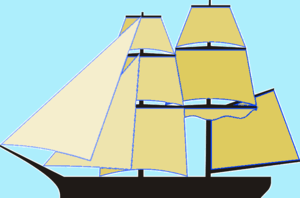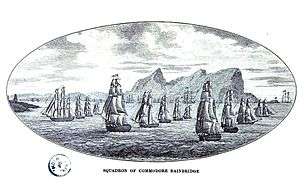USS Firefly (1814)
The USS Firefly, was a brig with two masts, square-rigged, formerly named Volant and originally built as a schooner for use as a privateer. The vessel was purchased at New York by the U.S. Navy on 8 December 1814 and was fitted out as US war ship with 14 guns and used in service during the War of 1812 and Second Barbary War of 1815. Firefly was purchased because of the several US blockade efforts where smaller ships with better maneuverability were needed for the task.
 Configuration of typical brig | |
| History | |
|---|---|
| Name: | USS Firefly |
| Builder: | Baltimore, Marland |
| Acquired: | 8 Dec 1814 |
| Fate: | Sold at New York, 3 April 1816 |
| General characteristics | |
| Type: | Brig |
| Tons burthen: | 333 (bm) |
| Length: |
|
| Beam: | 29 ft 4 in (8.94 m) |
| Draft: | 11 ft 6 in (3.51 m) |
| Complement: | 100 |
| Armament: |
|
History

In 1814, during the War of 1812, Firefly became the flagship of a squadron of five small ships which, under the command of Captain David Porter, were preparing for a mission to the West Indies to capture or destroy enemy commerce. However the mission was canceled when a peace treaty with Britain was signed on 24 December.[1]
On 20 May 1815, during the Second Barbary War, command of the Firefly was given to Lieutenant George W. Rodgers who departed from New York for the Mediterranean to join the squadron of Commodore Stephen Decatur. After a few days at sea Rodgers' squadron encountered a heavy gale and Firefly sprung a mast, forcing her to return to port for repairs.[1][2]
After repairs were completed Firefly set sail again for the Mediterranean on 18 July where she joined Commodore William Bainbridge's and Decatur's squadrons at Carthagena where preparations for the mission at Algiers were being made. From there the squadrons sailed to Algiers and spend the next several months maintaining the blockade and enforcing the peace concluded with the Dey of Algiers by Commodore Decatur and William Shaler, US Consul to Algiers.[3][4]
On 15 November 1815 Firefly arrived with the squadron at Newport, R.I., then sailed on to New York where she was laid up at the navy yard where she was later sold at public auction on 3 April 1816 at New York.[5]
She apparently became the slaver Africano,[6] or San Francisco de Paula.[7]
See also
- List of schooners
- Glossary of nautical terms
- Piracy in the Caribbean
- West Indies Anti-Piracy Operations of the United States
Citations
- Leiner, 2007 p.74
- Allen, 1905, p.282
- Allen, 1905, p.293
- Tucker, 2004 p.11
- Canney, 2001 p.177
- Naval Chronicle, Vol. 37, p.106.
- Walker, Andrew (2019) "Illegal Under the Laws of All Nations? The Courts of Haiti and the Suppression of the Atlantic Trade in African Captives", Law and History Review.
- This article incorporates text from the public domain Dictionary of American Naval Fighting Ships. The entry can be found here.
Further reading
- Allen, Gardner Weld (1905). Our Navy and the Barbary Corsairs.
Houghton Mifflin & Co., Boston, New York and Chicago. p. 354. OCLC 2618279. E'Book - Canney, Donald L. (1826). Sailing warships of the US Navy.
Chatham Publishing / Naval Institute Press. p. 224. ISBN 1-55750-990-5. Book - Leiner, Frederic C. (2007). The End of Barbary Terror, America's 1815 War against the Pirates of North Africa.
Oxford University Press, 2007. p. 256. ISBN 9780195325409. Book - Optic , Oliver (1891). Brave Old Salt: or, Life on the quarter deck. A story of the great rebellion.
Lothrop, Lee and Shepard Co., Boston. p. 326. E'Book - Tucker, Spencer (2004). Stephen Decatur: a life most bold and daring.
Naval Institute Press, 2004 Annapolis, MD. p. 245. ISBN 1-55750-999-9. Book